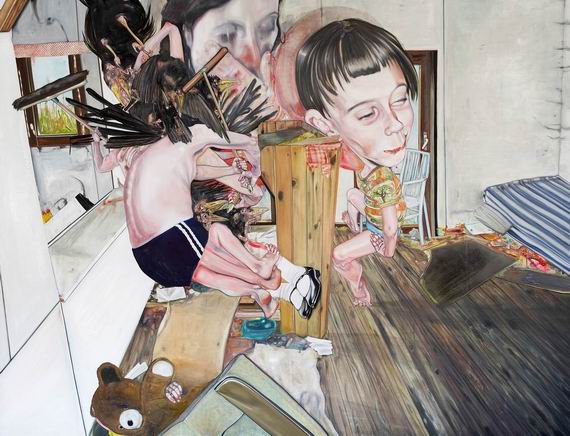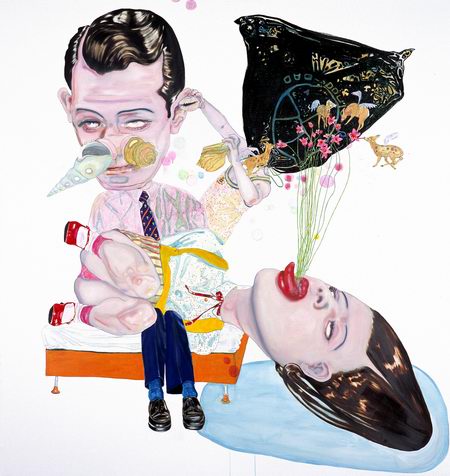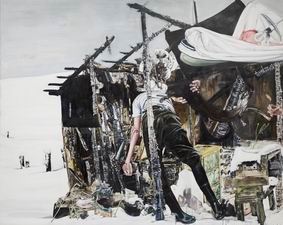
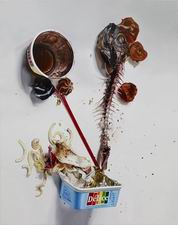
LÉOPOLD & TILL RABUS
Entre différence et complicité
January 24 to March 7, 2009
Opening Friday, January 23, 6 PM
Motives belonging to black romanticism traverse through Leopold Rabus’s entire work. His works irritate in many aspects for his fascinating subject matter, which appears to come from another world and is segregated into numerous perspectives, is juxtaposed by a precise painting technique akin to that of a virtuoso. Like in phantasmagoric dreams, grotesque characters appear as if frozen in irrational positions. Yet it is exactly these exaltedly morbid deformities, which open an almost impressionistic passage towards reality for Léopold Rabus. After all, the cradle of his illustrations is often to be found in his immediate past, whereby the recollection of these very events, exercised in a romantically melancholic manner, is blurred and has faded over time. Ostensively inspiring for Léopold Rabus is the everyday, marked by its banal moments and ordinary places. The rural idyll, however, is contaminated due to Léopold Rabus’s adoption of a dream as a medium for the illustration of these very unwanted memories. Léopold Rabus doesn’t intend on creating a shocking setting, but nevertheless, his characters from the animal kingdom and human society seem dismal and morbid. The excessive composition of deformation and grimaces often grants the works certain humorous elements. Paradoxically, a decadently aesthetic from of attraction additionally emerges from these characters and the observer thereby finds himself taking on the role of a voyeur, observing the somewhat spine-tingling occurrence or the portraits of seemingly demon-like animals, as if compelled to. In addition to the antique framing of the animal portraits, the pictorial tradition of landscape and genre painting helps in terms of distraction. To a certain extent, Léopold Rabus pursues this tradition, integrating analogous elements in his paintings.
What brother Léopold tries to achieve through landscape and genre painting is pursued by Till Rabus with reference to the tradition of the Vanitas in still life painting. His arrangements of food scraps and packaging materials seem grotesquely horrifying, yet nonetheless, your focus tends to remain fixed due to the work’s technical brilliance. From a technical point of view, the works, arranged as a series, refer to hyper-realism and to American photorealism of the 1960’s. Associations to pop art can be drawn through the illustration of everyday objects. Till Rabus establishes ties to the pictorial tradition of old master painting and its iconography, resorting to a form of radical realism. However a quasi half-aerated veil invariably lies over his works, allowing us to get a slight glimpse of today’s cold brutality.
Henceforth, black romanticism is categorically common to both oeuvres. They address loss, the past, and the ephemeral, and glance shrouded at our conception of reality.
|
|
|
|
|
Léopold Rabus: Corbeau mort, 2007 |
|
|
|
|
Frankfurt am Main, Oktober 2004 - He spends his nights with Russian street musicians, wants to travel alone through Siberia in his camper van and hugely loves acting. Léopold Rabus is very headstrong. This is visible in the art of the 26 year old. In its exhibition “Scène Sainte“, Gallery Adler of Frankfurt am Main, Germany presents not only large format paintings of the young Swiss, but also an installation
On his canvasses strange beings cavort in almost surrealistic fashion. Again and again the painter appears in shape of a young woman with long black hair. In most cases this is real hair. Even his technique is very specific to him: Léopold Rabus for example uses fleshy wax, bright nail varnish or playful glitter particles and thus gives his paintings a three-dimensional appearance. “Breathing space“ in his pictures is created by generous spaces of unpainted canvas, with his beings creating a microcosm of their own.
What on first glance appears amusing almost always goes deeper than that. In his most recent series ”Scène Sainte“, you will find humans intriguingly missing something. They weep, but their tears often are frozen. There are deer, some with wings, “Angels from another, fantastic, magical world“, according to Rabus. They drink the tears. The human beings finally receive what they missed, ascend to heaven and become saints themselves. The artist was, amongst others, inspired by the painting “Ofelia“, by 19th century John Everett Millais.
His last but one series Rabus called ”Ex Voto“. There he alludes to religious altar paintings and initiates discussions about religious feelings, promises of salvation and bigotry. Madonnas, Mormons, “whores and saints” are all part of „Ex Voto“. Rabus surprises, disgusts as well as fascinates the viewer and states, not without a certain amount of self-confidence: „I canonize some people or excommunicate them. In order to express feelings or experiences more easily, I let myself be inspired by folkloristic masks or popular presentations of saints and village life. Man has always, when you go back in time, gone down on his knees in order to praise or condemn God, a tree or a bottle...“
With Léopold Rabus Gallery Adler once more enhances its programme with an interesting, very young artist. As the sole representative of the Swiss artist in Germany, it is expanding its international circle of artists after having exhibited shooting star Alex McQuilkin and Klaus Wanker from Austria.
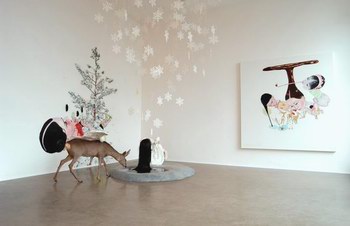 Gallery view: Mural, Installation "Stoup", Painting "Scène Sainte" |
|
|
|
